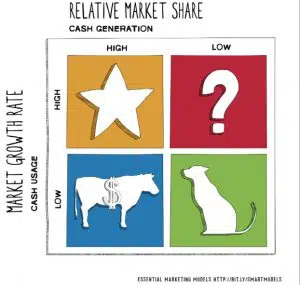This week has been very busy and productive and has reminded me that no small business owner should lose sight of enjoying the venture which you chose to establish. Is there a trick to having a business which can grow while you can enjoy seeing it flourish? The trick which I would encourage my clients to consider is carefully considered management of your product portfolio. This activity is equally important regardless of whether you supply physical products or a service. Take some time to manage your product portfolio by applying this matrix, which was originally developed by the Boston Consulting Group in 1968, and is usually referred to as the BCG matrix. First, you’ll need to do some analysis of your portfolio after which you will be in a strong position to make a plan and take action.
BCG matrix: the analysis phase

Here’s a brief introduction to the matrix and how to use it for your small business:
The idea is to review your existing product range and to allocate each product or service package into one of these four quadrants. But how do you allocate? What do the images/names mean?
A large manufacturer such as Kraft would allocate by adhering closely to the original theory which requires access to detailed market research information including market share and market growth figures. Clearly, it is unlikely that small business owners will have access to such data, indeed, if it even exists for their output. I would suggest an alternative approach which is more realistic and practical for small independent business owners, yet stays true to the academic concept of the original BCG matrix. Just allocate your products to a quadrant by using a combination of hard, financial data and your instinctive gut-feel; there’s nothing wrong with trusting your own judgement. Consider the descriptors as follows:
Cash cows are products which perform fairly reliably for you and deliver a surplus to your bottom-line. This is where the true engine of your business lies.
Question marks are those products which might be costing you money. You don’t sell much, yet there are indicators which suggest that there is potential for greater success in the future. This might mean that you’d need to plan to adapt to meet future growth by, for example, hiring an additional treatment room and therapist.
Star would be the correct label to give to any product which has achieved leadership in a growing market. It will be delivering a profit to your bottom-line, in part thanks to the amount sold. However, be aware that stars require nurturing and investment to protect them from the tactics which might be deployed by competitors which might attempt to steal market share from Stars. An example of a current star is the ticket-seller Eventbrite, which has secured itself a market-leading position, yet needs to prepare for the onset of many competitors which aim to steal their share of this relatively new/growing market. If Eventbrite doesn’t follow an appropriate strategy to develop its star into a cash-cow, it may lose out in the future.
Dog is a product that would be allocated to the this quadrant if you’re selling few and those sales deliver minimal profit and might return a loss. Your business doesn’t want dogs!
As always, I will practise what I preach. I have analysed my business to discover one cash cow, no stars, and one question (possibly one dog so this one needs more reflection).
Once you have identified where your current output sits in the matrix you will be ready to move from the analytical phase to the activity driven phase. The thesis of the BCG matrix is the process of understanding the mix of your product portfolio so that you can prepare for the future by maintaining a balanced portfolio with today’s bread-winners funding those of tomorrow. Ideally, you should aim to invest the surplus from any cash-cows into the question marks to enable growth in the hope that the ‘?’ becomes a star or cash-cow of the future. If you balance your product portfolio correctly, your business might be able to run itself for a short while. You cannot become complacent, but you can at least begin to enjoy what you do in the knowledge that you are already anticipating the future for your business and allocating funds and effort wisely.
If you would like guidance on how to manage your product portfolio and how to find the fun in your business please consider booking an appointment at my Marketing Clinic or email: [email protected] to choose a convenient venue to meet me Trinity café or Daily Rusthall clinics https://lisabeaumontmarketing.co.uk/marketing-clinic-form/

